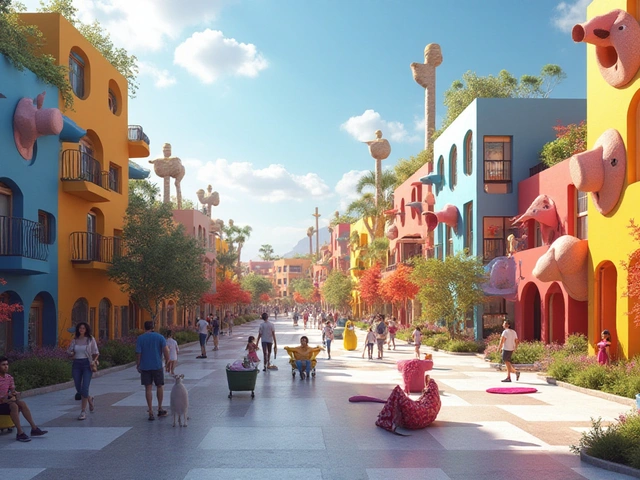If you’ve ever wandered around Paris or the grand avenues of New York and felt suddenly wowed—like you accidentally stumbled into a scene from The Great Gatsby—it’s probably because of Beaux-Arts architecture. This style demands attention, dressed head to toe in marble columns, massive staircases, and just the right amount of gold leaf. The secret? It isn’t just about looking lavish. Every element has a purpose, a nod to centuries of classical tradition mixed with the wild optimism of the 19th century. And here’s the kicker: even after more than 150 years, Beaux-Arts buildings still feel fresh—elegant without being stuffy, grand without being cold.
How Beaux-Arts Architecture Sparked a Design Revolution
Beaux-Arts style wasn’t born in a vacuum; it grew up in Paris at the famous École des Beaux-Arts, a school where architects were trained almost like artists. The French didn’t just teach design—they taught storytelling through stone. By the late 1800s, the appeal of this over-the-top, highly-ordered style was spreading, especially after the extravagant 1893 World’s Columbian Exposition in Chicago. People couldn't get enough of the domes, the symmetry, the flourishes.
Think of it as the architectural world’s version of a blockbuster movie. Every major city wanted its own slice of drama. Architects who studied in Paris brought back tons of sketches and wild ideas for new libraries, post offices, train stations, and opera houses. In fact, Grand Central Terminal in New York is a classic example, packed with soaring ceilings, massive columns, and electric chandeliers—an energy that makes even waiting for a train feel like an event. It was about civic pride as much as beauty. Cities wanted their public buildings to inspire as much awe as a cathedral.
Beaux-Arts wasn’t afraid to show off. Everything—from the smallest iron-rimmed door to the tallest marble stair—was carefully considered. Many American architects, like Richard Morris Hunt and Cass Gilbert, made pilgrimages to Paris, and then unleashed the style on landmarks such as the New York Public Library, the Boston Public Library, and the dome of San Francisco’s City Hall. These structures became gathering places, wedding backdrops, must-see movie scenes, and, eventually, reminders of a moment when optimism and artistry were in perfect sync.
One quirky fact: the style borrowed a lot from classical Roman and Greek architecture but wasn’t just a copycat. It fearlessly mixed things up, throwing in Renaissance and Baroque drama whenever possible. Take a trip to the Petit Palais or the Grand Palais in Paris, and you’ll see what I mean. It’s like all the greatest hits of Western architecture mashed into one powerful show.
Spotting Beaux-Arts: What Sets It Apart?
If you’re trying to spot a Beaux-Arts masterpiece, get ready to play detective with a long checklist. These buildings leave clues everywhere. Start with the main entrance. Is it big, bold, and loaded with sculpted details—gigantic columns, swooping arches, or stone angels perched at the top? That’s your first sign. Beaux-Arts buildings have a love affair with symmetrical facades, meaning everything lines up perfectly right and left, no matter how over-the-top the details get.
Move a bit closer and notice the windows and doors—usually grand, often triple-layered, piled with carvings or dramatic glass. The rooftops tend to be flat or ever-so-gently sloped, with balustrades and a parade of statues or urns peering over the edge. The French called these roofs “mansard” after the architect François Mansart, who was a bit of a roof rebel in his day.
When you walk inside, the drama ramps up. High ceilings, skylights, rich marbles, and often, murals that tell epic stories or nod to science, music, or history. Every corner has a detail worth gawking at. Sometimes, the staircases feel like floating sculptures—you almost expect to spot a flapper or tuxedoed gentleman descending in slow motion.
- Beaux-Arts architecture is famous for its grand entrances and ceremonial stairs.
- Interiors are just as impressive as exteriors, with detailed molding, frescoes, and gigantic chandeliers.
- Outdoor spaces play a part, too: fountains, ornamental gardens, broad promenades, sometimes even reflecting pools.
- Materials often mix old with new: classic stone, marble, and iron with cutting-edge tech for the time (like glass skylights and steel frames hidden behind beautiful facades).
If you want to start recognizing Beaux-Arts style, start visiting your city’s museums, train stations, and government buildings. Chances are, at least one of them owes its grandeur to this movement. Even the interiors of classic department stores and hotels got the Beaux-Arts makeover, especially before Art Deco crashed the party in the 1920s.
Why People Still Love Beaux-Arts (and How to Channel It Today)
The thing about Beaux-Arts style is its ageless appeal. Sure, you might not want a 10-ton stone griffin guarding your apartment, but there’s something about the balance, order, and storytelling in this style that feels just right—even today. Designers and home renovators keep coming back to it for a sense of permanent luxury and harmony.
Here’s a tip if you want to sprinkle a little Beaux-Arts DNA into your own space without turning your living room into Versailles: focus on symmetry and dramatic focal points. Got a favorite painting or a piano? Let it take center stage, and arrange furniture to frame it—almost like those grand staircases in old train stations. Use rich materials when you can: think velvet, glass, metallic touches, or even plush curtains. Don’t be afraid of a little drama in your lighting choices—maybe a chandelier or statement lamp.
For those who love a project, molding and trim add easy elegance, especially over doors and around ceilings. Mirrors aren’t just for checking your hair—they bounce light around and can hint at the endless halls and domes in big Beaux-Arts spaces. If you’re lucky enough to have tall ceilings, go big with wall art or curtains that hang all the way to the floor. It’s about channeling the mood—not copying the past, but giving it new life.
There’s a movement among architects and preservationists to save and adapt Beaux-Arts buildings rather than tear them down. These places are getting reimagined as galleries, restaurants, concert halls, and even chic apartments. The bones are just too good to waste. Even the most minimalist designers secretly love to borrow a little Beaux-Arts grandeur—a colonnade here, a dramatic staircase there.
Another secret: plenty of new buildings use just enough Beaux-Arts detailing to make them feel rooted, without going full palace mode. Look at hotels in New York or redesigns of old Parisian offices, and you’ll spot nods to the style in floor patterns, ceiling medallions, and skylit lobbies.
Iconic Beaux-Arts Buildings and Their Cultural Power
If you want a crash course in Beaux-Arts in action, you need to check out a few jaw-dropping buildings. Grand Central Terminal shines as probably the world’s most famous example—a train station where the ceiling is painted with the night sky, and gold chandeliers rain down light from thirty meters above. More than 750,000 people pass through it every day, but walk inside and you might just stare up, missing your train entirely.
In Washington, D.C., Union Station combines classical symmetry with some pretty wild details (trust me, don’t skip the gilded ceilings). The Paris Opéra Garnier is the definition of over-the-top, with enough marble, mirrors, and gold leaf to dazzle even the steeliest tourist. In San Francisco, City Hall’s blue-gray dome towers over the city, filled with marble halls that have seen weddings, protests, and everything in between. Each one is a cultural eventspace as much as a working building. These are places where history and daily life meet—a living stage set for the city.
If you’re chasing surprises, try the Palais Garnier’s “phantom’s box” (Box Number 5)—yes, the real one. Or visit the Musée d’Orsay, a Beaux-Arts train station turned art museum, where Monet and Van Gogh hang out beneath giant clocks and vaulted ceilings. Even if you can’t hop on a flight, virtual tours and Google Street View let you wander these spaces remotely. It’s all proof that beauty has staying power, and good bones make for better memories.
One last fun fact: in 2022, researchers analyzing the cooling effects of Beaux-Arts buildings in heatwaves found that their thick stone walls and clever ventilation actually kept interiors much cooler than modern glass towers. Maybe it’s time to rethink “old-fashioned” architecture after all.
The next time you find yourself looking up at a dramatic dome or gazing at a pair of fierce stone lions outside a museum, remember: this isn’t just decoration. It’s the past and present having a conversation—reminding us that, deep down, everyone loves a bit of grandeur now and then.



